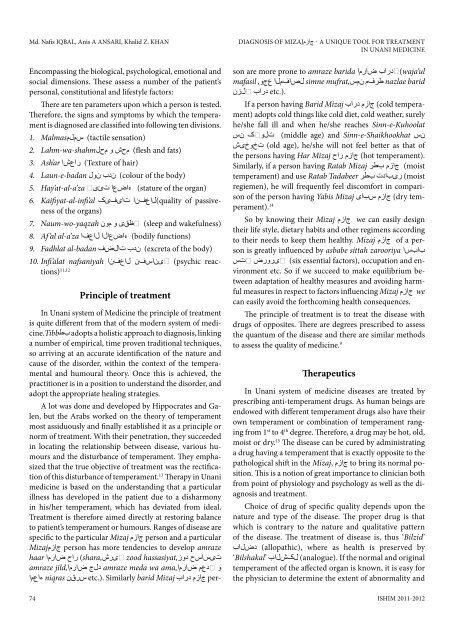Journal of - International Society for the History of Islamic Medicine
Journal of - International Society for the History of Islamic Medicine
Journal of - International Society for the History of Islamic Medicine
Create successful ePaper yourself
Turn your PDF publications into a flip-book with our unique Google optimized e-Paper software.
Md. Nafis IQBAL, Anis A ANSARI, Khalid Z. KHAN<br />
Diagnosis <strong>of</strong> جازمMizaj - a Unique Tool <strong>for</strong> Treatment<br />
in Unani <strong>Medicine</strong><br />
Encompassing <strong>the</strong> biological, psychological, emotional and<br />
social dimensions. These assess a number <strong>of</strong> <strong>the</strong> patient’s<br />
personal, constitutional and lifestyle factors:<br />
There are ten parameters upon which a person is tested.<br />
There<strong>for</strong>e, <strong>the</strong> signs and symptoms by which <strong>the</strong> temperament<br />
is diagnosed are classified into following ten divisions.<br />
1. سملمMalmas (tactile sensation)<br />
2. محش و محلLahm-wa-shahm (flesh and fats)<br />
3. Ash’ar راعشا (Texture <strong>of</strong> hair)<br />
4. Laun-e-badan ندب نول (colour <strong>of</strong> <strong>the</strong> body)<br />
5. Hay’at-al-a’za ءاضعا تئیٱ (stature <strong>of</strong> <strong>the</strong> organ)<br />
6. Kaifiyat-al-infi’al تایفیک quality)لاعفنا <strong>of</strong> passiveness<br />
<strong>of</strong> <strong>the</strong> organs)<br />
7. Naum-wo-yaqzah ٱظقی و مون (sleep and wakefulness)<br />
8. Af’al al-a’za ءاضعالا لاعفا (bodily functions)<br />
9. Fadhlat al-badan ندب تالضف (excreta <strong>of</strong> <strong>the</strong> body)<br />
10. Infi’alat nafsaniyah ٱیناسفن لاعفنا (psychic reactions)<br />
11,12<br />
Principle <strong>of</strong> treatment<br />
In Unani system <strong>of</strong> <strong>Medicine</strong> <strong>the</strong> principle <strong>of</strong> treatment<br />
is quite different from that <strong>of</strong> <strong>the</strong> modern system <strong>of</strong> mediبطcine.Tibb<br />
adopts a holistic approach to diagnosis, linking<br />
a number <strong>of</strong> empirical, time proven traditional techniques,<br />
so arriving at an accurate identification <strong>of</strong> <strong>the</strong> nature and<br />
cause <strong>of</strong> <strong>the</strong> disorder, within <strong>the</strong> context <strong>of</strong> <strong>the</strong> temperamental<br />
and humoural <strong>the</strong>ory. Once this is achieved, <strong>the</strong><br />
practitioner is in a position to understand <strong>the</strong> disorder, and<br />
adopt <strong>the</strong> appropriate healing strategies.<br />
A lot was done and developed by Hippocrates and Galen,<br />
but <strong>the</strong> Arabs worked on <strong>the</strong> <strong>the</strong>ory <strong>of</strong> temperament<br />
most assiduously and finally established it as a principle or<br />
norm <strong>of</strong> treatment. With <strong>the</strong>ir penetration, <strong>the</strong>y succeeded<br />
in locating <strong>the</strong> relationship between disease, various humours<br />
and <strong>the</strong> disturbance <strong>of</strong> temperament. They emphasized<br />
that <strong>the</strong> true objective <strong>of</strong> treatment was <strong>the</strong> rectification<br />
<strong>of</strong> this disturbance <strong>of</strong> temperament. 13 Therapy in Unani<br />
medicine is based on <strong>the</strong> understanding that a particular<br />
illness has developed in <strong>the</strong> patient due to a disharmony<br />
in his/her temperament, which has deviated from ideal.<br />
Treatment is <strong>the</strong>re<strong>for</strong>e aimed directly at restoring balance<br />
to patient’s temperament or humours. Ranges <strong>of</strong> disease are<br />
specific to <strong>the</strong> particular Mizaj جازم person and a particular<br />
جازمMizaj person has more tendencies to develop amraze<br />
تیساسح دوز,hassasiyat zood ٱیرش,shara) راح ضارما haar<br />
و ٱدعم ضارما,ama amraze meda wa دلج ضارما,jild amraze<br />
per- جازم دراب etc.). Similarly barid Mizaj سرقن niqras ءاعما<br />
son are more prone to amraze barida ضارما waja’ul)ٱدراب<br />
mafasil لصافملا عجو, simne طرفم نمس,mufrat nazlae barid<br />
etc.). دراب ٱلزن<br />
If a person having Barid Mizaj جازم دراب (cold temperament)<br />
adopts cold things like cold diet, cold wea<strong>the</strong>r, surely<br />
he/she fall ill and when he/she reaches Sinn-e-Kuhoolat<br />
نس (middle age) and Sinn-e-Shaikhookhat تلوٱک نس<br />
(old age), he/she will not feel better as that <strong>of</strong> تخوخیش<br />
<strong>the</strong> persons having Har Mizaj جازم راح (hot temperament).<br />
Similarly, if a person having Ratab Mizaj جازم بطر (moist<br />
temperament) and use Ratab Tadabeer ریبادت بطر (moist<br />
regiemen), he will frequently feel discom<strong>for</strong>t in comparison<br />
<strong>of</strong> <strong>the</strong> person having Yabis Mizaj جازم سبای (dry temperament).<br />
14<br />
So by knowing <strong>the</strong>ir Mizaj جازم we can easily design<br />
<strong>the</strong>ir life style, dietary habits and o<strong>the</strong>r regimens according<br />
to <strong>the</strong>ir needs to keep <strong>the</strong>m healthy. Mizaj جازم <strong>of</strong> a per-<br />
بابسا son is greatly influenced by asbabe sittah zarooriya<br />
en- (six essential factors), occupation and ٱیرورض ٱتس<br />
vironment etc. So if we succeed to make equilibrium between<br />
adaptation <strong>of</strong> healthy measures and avoiding harmful<br />
measures in respect to factors influencing Mizaj جازم we<br />
can easily avoid <strong>the</strong> <strong>for</strong>thcoming health consequences.<br />
The principle <strong>of</strong> treatment is to treat <strong>the</strong> disease with<br />
drugs <strong>of</strong> opposites. There are degrees prescribed to assess<br />
<strong>the</strong> quantum <strong>of</strong> <strong>the</strong> disease and <strong>the</strong>re are similar methods<br />
to assess <strong>the</strong> quality <strong>of</strong> medicine. 9<br />
Therapeutics<br />
In Unani system <strong>of</strong> medicine diseases are treated by<br />
prescribing anti-temperament drugs. As human beings are<br />
endowed with different temperament drugs also have <strong>the</strong>ir<br />
own temperament or combination <strong>of</strong> temperament ranging<br />
from 1 st to 4 th degree. There<strong>for</strong>e, a drug may be hot, old,<br />
moist or dry. 15 The disease can be cured by administrating<br />
a drug having a temperament that is exactly opposite to <strong>the</strong><br />
pathological shift in <strong>the</strong> Mizaj, جازم to bring its normal position.<br />
This is a notion <strong>of</strong> great importance to clinician both<br />
from point <strong>of</strong> physiology and psychology as well as <strong>the</strong> diagnosis<br />
and treatment.<br />
Choice <strong>of</strong> drug <strong>of</strong> specific quality depends upon <strong>the</strong><br />
nature and type <strong>of</strong> <strong>the</strong> disease. The proper drug is that<br />
which is contrary to <strong>the</strong> nature and qualitative pattern<br />
<strong>of</strong> <strong>the</strong> disease. The treatment <strong>of</strong> disease is, thus ‘Bilzid’<br />
(allopathic), where as health is preserved by دضلاب<br />
‘Bilshakal’ لکشلاب (analogue). If <strong>the</strong> normal and original<br />
temperament <strong>of</strong> <strong>the</strong> affected organ is known, it is easy <strong>for</strong><br />
<strong>the</strong> physician to determine <strong>the</strong> extent <strong>of</strong> abnormality and<br />
74<br />
ISHIM 2011-2012
















